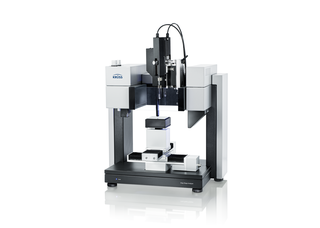Pendant drop
The pendant drop is a drop suspended from a needle in a bulk liquid or gaseous phase. The shape of the drop results from the relationship between the surface tension or interfacial tension and gravity. In the pendant drop method, the surface tension or interfacial tension is calculated from the shadow image of a pendant drop using drop shape analysis.
Background
An increased pressure is produced inside the drop as a result of the interfacial tension between inner and outer phase. The correlation between the pressure difference Δp, the radii of curvature of the surface r1 and r2 and the interfacial tension is described by the Young- Laplace equation:

The pendant drop is deformed under the effect of gravity, as a hydrostatic pressure which affects the main radii of curvature r1 and r2 is produced inside the drop due to the weight.

As the hydrostatic pressure is dependent on height, the curvature of the drop interface also changes in the vertical direction. This results in the characteristic "pear shape" of a pendant drop.
The degree of deviation from the spherical shape is given by the ratio between the weight of the drop and its surface tension. If the density difference between the phases is known, the surface tension can be calculated from the shape of the drop. The shape cannot be scaled at will; in fact the actual dimensions of the drop are used in the calculation.
When making a measurement, the scale of the video image is measured first in order to give access to the actual drop dimensions. The shape of the drop is then determined from the video image of the dosed drop using greyscale analysis. A shape parameter designated by B is then varied in a numerical method until the calculated drop shape corresponds with the actual shape. The interfacial tension is calculated from the density difference Δρ and the modified B parameter.



